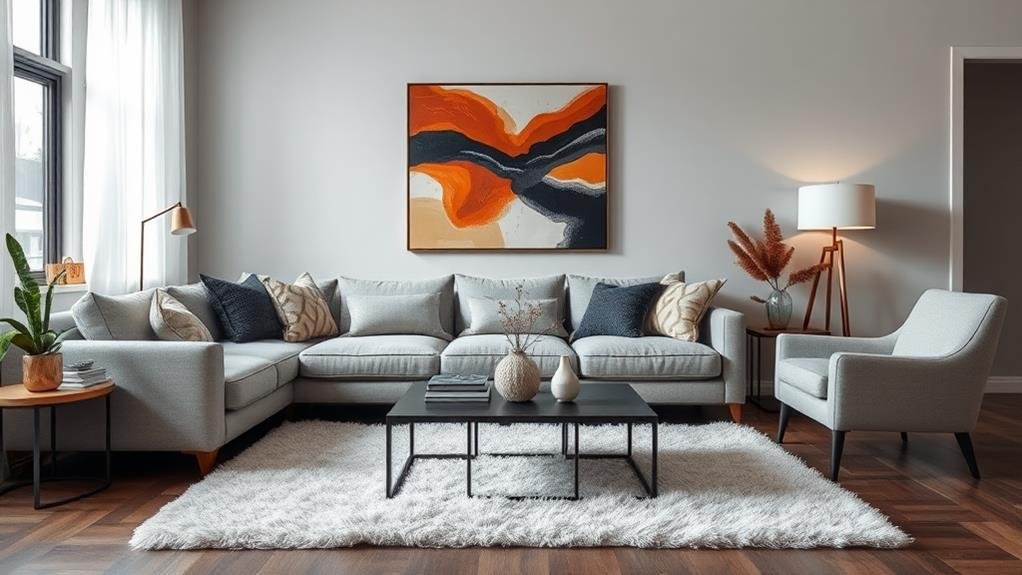To craft a captivating interior design, focus on essential elements like color palettes, furniture selection, lighting placement, textures, room layout, accessories, storage solutions, and personal touches. Play with blues for calmness or yellows for energy, balance aesthetics and usability of furniture, utilize different lighting types for functionality, mix textures for visual depth, optimize room pathways with smart layout, add personality with accents and trinkets, organize creatively with storage solutions, and infuse warmth with personal mementos. Mastering these elements helps you fashion spaces that are not only visually appealing but also deeply reflective of your unique style and character.
Key Takeaways
- Color palette selection influences mood and style.
- Furniture choice balances aesthetics and functionality.
- Lighting placement enhances ambience and functionality.
- Textures and fabrics add depth and visual interest.
- Room layout optimization improves flow and usability.
Color Palette
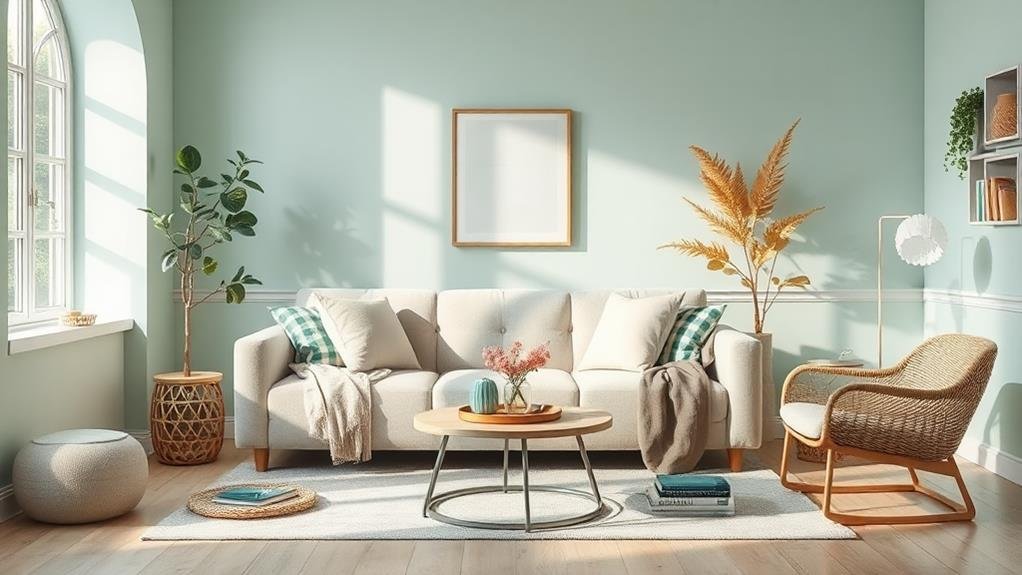
When it comes to crafting the perfect interior design, selecting the right color palette sets the tone for the entire space. Color psychology plays a vital role in how different hues can affect emotions and behaviors. Each color holds significance; for example, blues and greens are known for their calming effects, while yellows and oranges tend to energize.
Staying updated on color trends can help you create a modern and stylish space, reflecting the current mood of design. Understanding color theory is crucial in creating harmonious interiors. Exploring complementary colors and their combinations can help you achieve balance and visual interest.
Moreover, colors often carry cultural meanings that can add depth and richness to a room. Taking these meanings into account can help you create a space that resonates with personal or cultural significance.
Furniture Selection
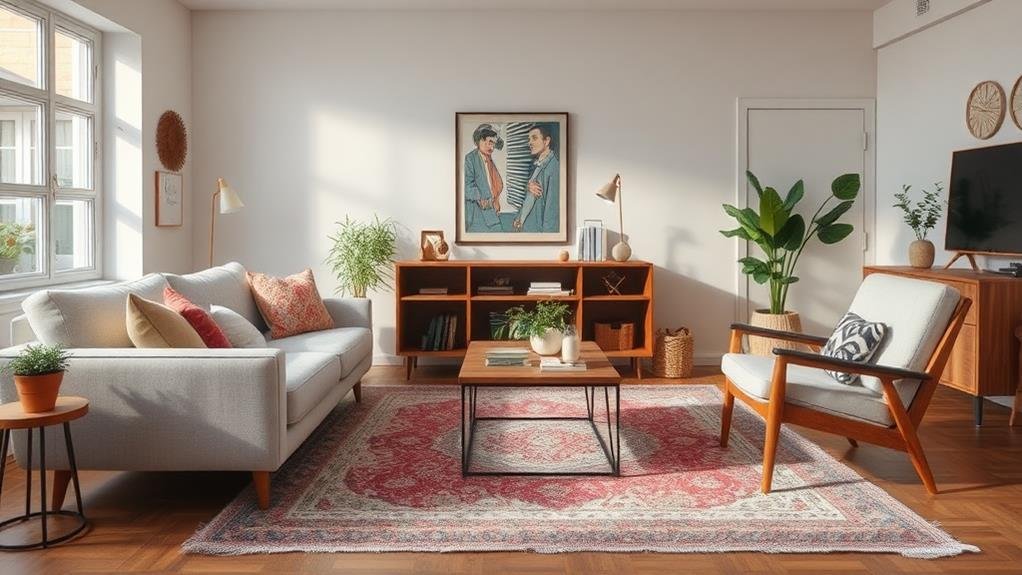
When it comes to selecting furniture for your space, you must consider the perfect balance between style and function.
Ensuring that your furniture complements the scale and proportion of the room is essential for a harmonious design.
Additionally, the choice of materials and textures can add depth and character to your interior, creating a visually appealing and cohesive environment.
Style and Function
As you delve into the realm of interior design, one crucial aspect that marries aesthetics and practicality is the meticulous art of furniture selection. Your choices in furniture not only define the style of a space but also serve functional purposes that cater to your daily needs.
When embarking on the journey of selecting furniture, consider the following:
- Design Principles: Understanding fundamental design principles can guide you in choosing furniture that harmonizes with the overall theme of your space.
- Aesthetic Appeal: Select pieces that not only look visually appealing but also complement the design elements present in the room.
- User Experience: Prioritize comfort and functionality to ensure that the furniture enhances the usability of the space.
- Cultural Influences: Incorporate elements that reflect your cultural background or draw inspiration from diverse cultural aesthetics.
- Sustainable Practices: Opt for furniture made from eco-friendly materials to support sustainability efforts in interior design.
Scale and Proportion
Embarking on your journey to curate a harmonious and functional interior space involves a meticulous consideration of scale and proportion when selecting furniture. Understanding scale relationships is crucial to ensure that each piece complements the others in the room.
One of the proportion guidelines to keep in mind is the 60-30-10 rule, where 60% of the room is a dominant color, 30% a secondary color, and 10% an accent color. Applying this principle to furniture selection can help maintain balance in the space.
When choosing furniture pieces, consider the size of the room and the intended functionality of the space. A large sofa in a small living room can overwhelm the area, whereas a smaller loveseat may provide a better fit. Mixing different furniture sizes can create visual interest and prevent monotony.
Additionally, be mindful of the height of the furniture in relation to the ceiling and other elements in the room to maintain proportion and flow seamlessly from one piece to another.
Material and Texture
Delving into the realm of material and texture in furniture selection unlocks a realm of possibilities to elevate your interior design.
When choosing materials and textures for your furniture pieces, consider the following:
- Material Sourcing: Explore unique sources for furniture materials to add individuality to your space.
- Texture Combinations: Experiment with blending different textures to create visual interest and sensory appeal.
- Sustainable Materials: Opt for eco-friendly options to reduce your environmental impact.
- Tactile Experiences: Prioritize comfort and touch-friendly textures for a cozy atmosphere.
- Visual Weight: Balance heavy and light materials to create a harmonious visual flow within your space.
Lighting Placement
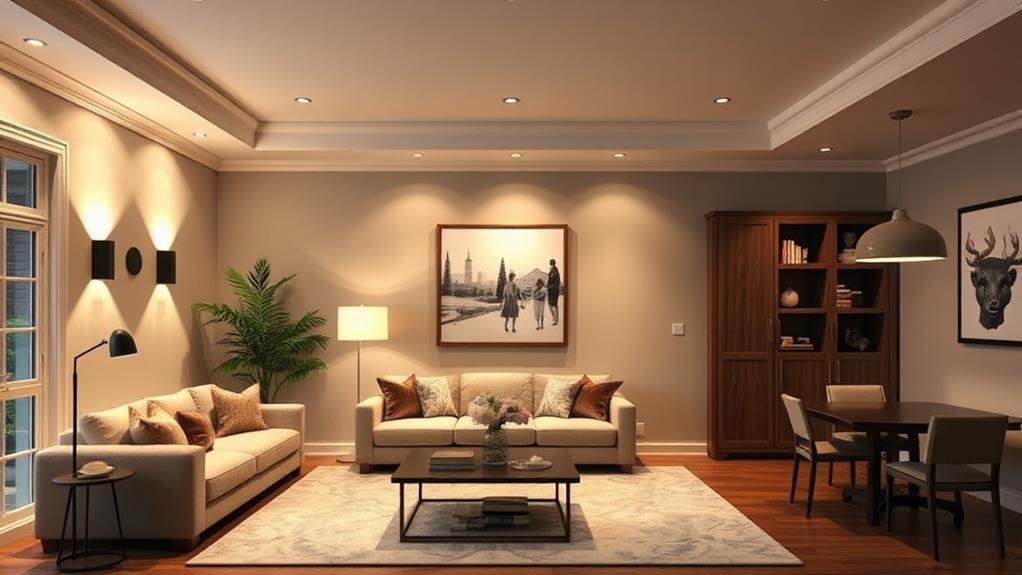
Positioning lighting fixtures effectively is a crucial aspect of interior design that can greatly impact the overall feel and functionality of a space. When planning the lighting layout for a room, consider incorporating a combination of ambient lighting, task lighting, and accent lighting.
Utilizing natural illumination whenever possible can enhance the ambiance and reduce the need for artificial light during the day.
Selecting the right fixtures is vital for achieving the desired atmosphere. By strategically layering different types of lighting, you can create depth and dimension within the room.
Keep in mind the color temperature of the bulbs to ensure they complement the room's color scheme and create the right mood.
Carefully positioned lights can also be used to play with shadow effects, adding drama and interest to the space.
Additionally, focus on energy efficiency by opting for LED fixtures and utilizing light control systems to adjust brightness levels as needed.
Texture and Fabric
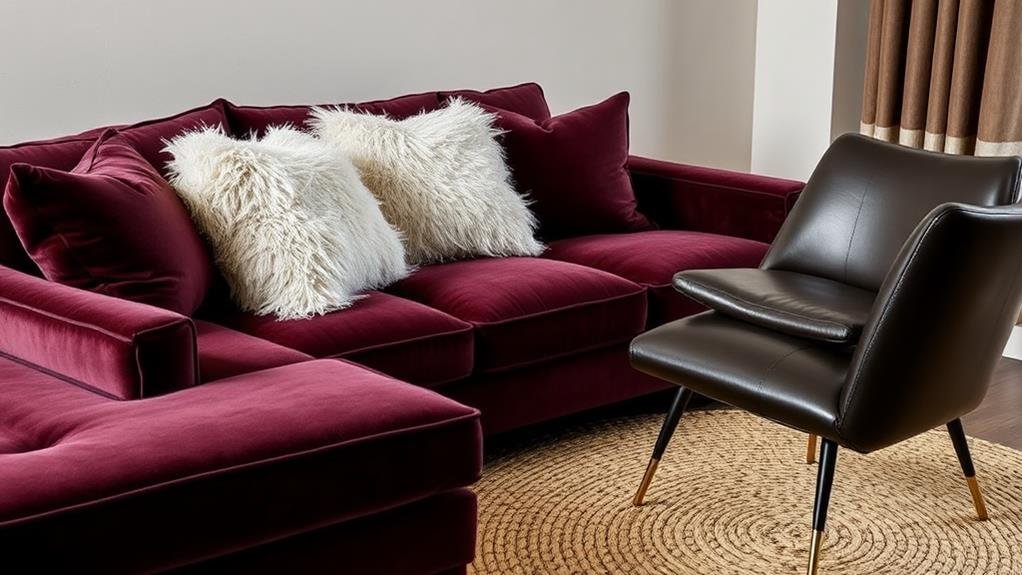
As you consider the elements of interior design that contribute to a harmonious and visually engaging space, the incorporation of texture and fabric plays a significant role in adding depth and personality to your home.
From fabric types to sustainable textiles, the choices you make can greatly impact the ambiance of your living space. Here are some key points to keep in mind:
- Texture Contrast: Experiment with different textures to create visual interest and depth in your decor.
- Textile Patterns: Incorporate patterns to add a dynamic element to your room design.
- Layering Fabrics: Consider layering different fabrics to enhance the tactile experiences within your space.
- Fabric Maintenance: Learn about proper fabric care to ensure longevity and freshness in your interior.
- Color Matching: Pay attention to how different fabrics interact with the color palette of your room for a cohesive look.
Exploring fabric trends and upholstery options can elevate your design scheme and offer endless possibilities for customization.
Room Layout
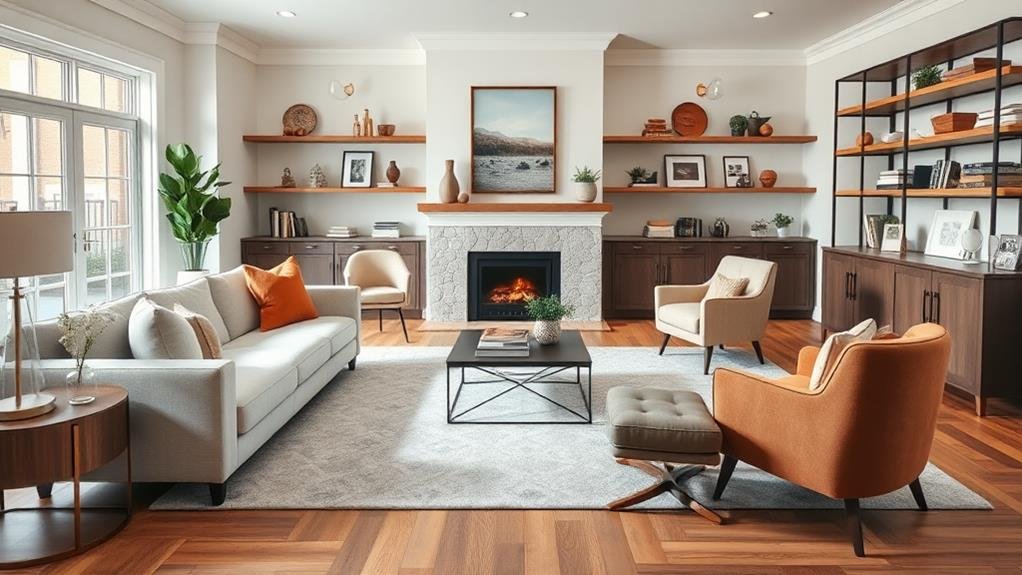
Navigating the intricacies of interior design, one crucial aspect that can truly transform the functionality and aesthetic appeal of a space is the arrangement of its elements.
When it comes to room layout, mastering zoning techniques and ensuring smooth traffic flow are key. Zoning involves dividing a room into specific functional areas based on activities like dining, lounging, or working. By defining these areas through the strategic placement of furniture and decor, you create a harmonious flow within the space.
To optimize traffic flow, consider the natural pathways people follow when moving through a room. Ensure there are clear walkways that aren't obstructed by furniture or decor.
The arrangement of furniture should facilitate movement, making it easy to navigate the space without feeling cramped or restricted.
Wall Art and Decor
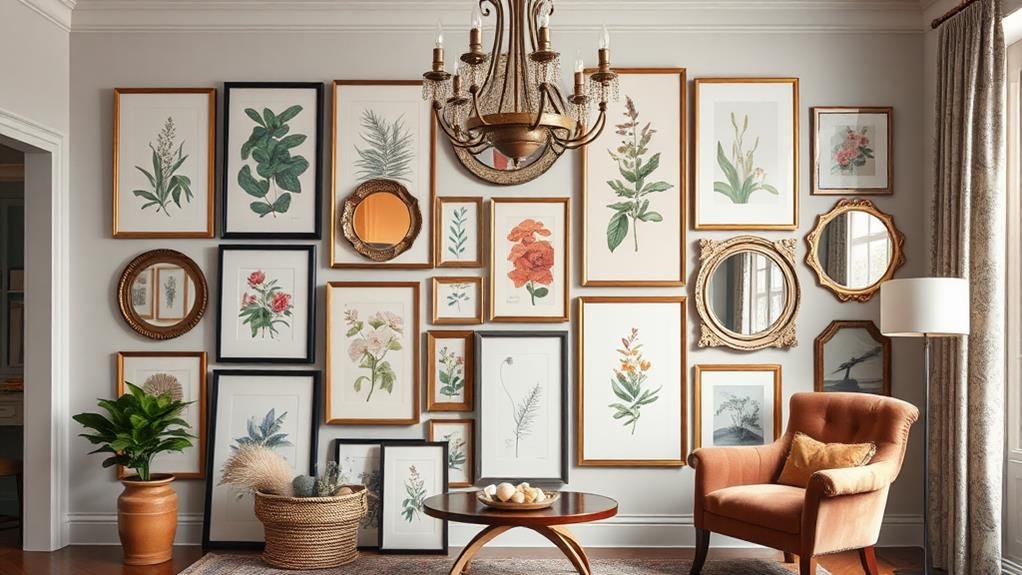
Creating a captivating atmosphere within your space goes beyond just furniture arrangement; it extends to the walls themselves. Your walls are a blank canvas waiting to be adorned with creativity and personality.
Here are some inspiring ideas to transform your walls into stunning focal points:
- Framed Photographs: Showcase your cherished memories or artistic captures in beautifully curated frames.
- Wall Sculptures: Add a touch of dimension and texture to your walls with intricate sculptures that reflect your style.
- Canvas Prints: Infuse your space with color and artistry using eye-catching canvas prints that speak to your aesthetic.
- Mural Designs: Make a bold statement with striking mural designs that can transport you to different worlds within your own home.
- Gallery Walls: Create a curated collection of art pieces, photographs, and decorative elements to elevate your space with a personalized touch.
Flooring Options
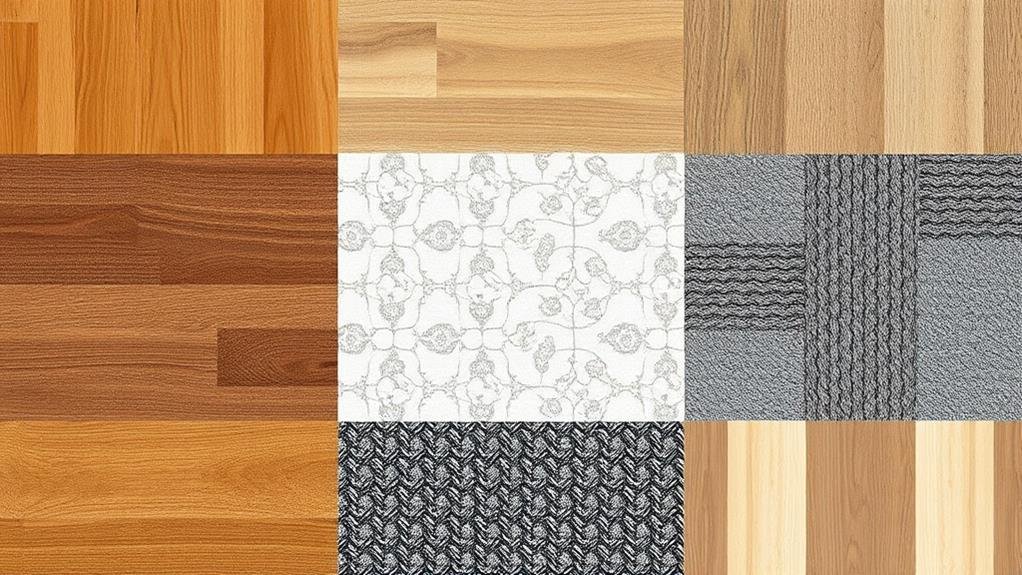
Wondering how to amplify the aesthetic appeal of your living space from the ground up? Your choice of flooring can completely transform a room. From classic hardwood varieties to intricate tile patterns, there are endless options to suit your style. Let's delve into some flooring choices and considerations:
| Flooring Type | Highlights |
|---|---|
| Hardwood Varieties | Timeless elegance, durability |
| Tile Patterns | Versatile designs, easy to clean |
| Carpet Textures | Soft underfoot, cozy atmosphere |
| Laminate Choices | Budget-friendly, simple maintenance |
| Eco-Friendly Options | Sustainable materials, health-conscious |
| Flooring Maintenance | Regular care, prolongs lifespan |
| Soundproofing Materials | Noise reduction, peaceful ambiance |
| Underfloor Heating | Comfortable warmth, energy-efficient |
| Area Rugs | Instant style update, easy to switch |
| Installation Methods | Professional touch, precise finish |
Consider your lifestyle, budget, and design preferences when choosing your flooring. Whether you opt for luxurious carpet textures or eco-friendly options, make sure to factor in maintenance and installation methods for a space that truly reflects your style.
Window Treatments
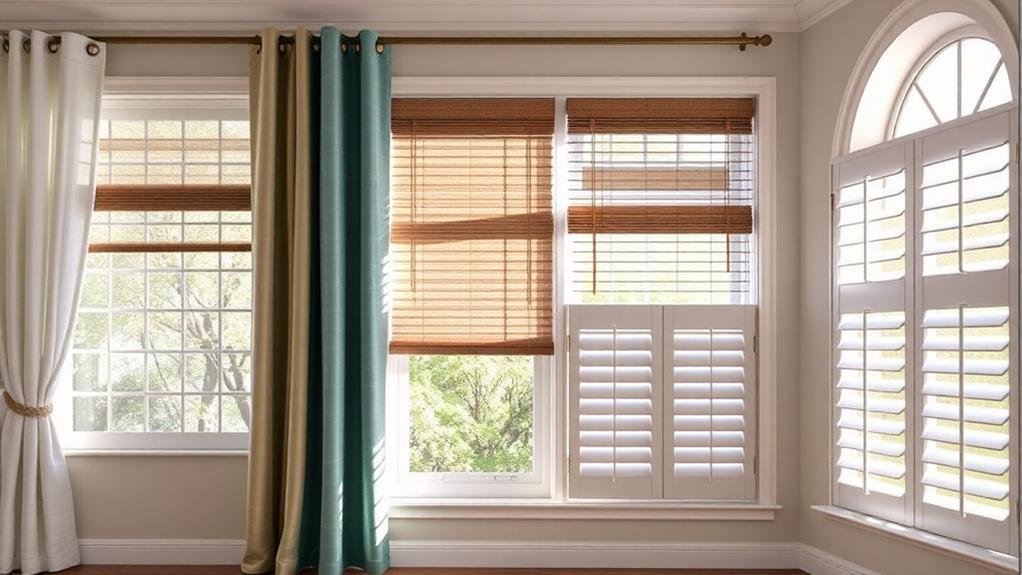
Let's talk window treatments.
From luxurious velvet drapes to sheer linen panels, you have a multitude of curtain fabric options to add texture and depth to your space.
Consider not just the style they bring to your windows, but also the functionality they offer in terms of privacy, light control, and energy efficiency.
Curtain Fabric Options
When selecting curtain fabric options for your interior design, it's crucial to consider both functionality and aesthetics. The fabric you choose can greatly impact the overall look and feel of a room, as well as how much light is allowed in.
Here are some considerations for each option:
- Sheer Options: Perfect for adding a touch of elegance while still allowing light to filter through, ideal for creating a soft, airy atmosphere.
- Blackout Fabrics: Great for bedrooms for blocking out light and maintaining privacy, these are excellent for creating a cozy and dark environment.
- Patterned Textiles: Add visual interest and personality to your space, while also helping to tie in different colors and design elements.
- Natural Fibers: Eco-friendly and add warmth to a room, these fabrics offer a touch of nature indoors and are perfect for a sustainable design approach.
- Synthetic Materials: Easy to maintain and durable, these are ideal for high-traffic areas and homes with pets or children.
Consider your lifestyle, maintenance preferences, and desired ambiance when selecting the perfect curtain fabric for your space.
Styles for Windows
Exploring the world of interior design through the lens of window treatments opens up a realm of possibilities to enhance your living spaces. When it comes to choosing styles for windows, consider the window shapes and architectural styles of your home to create a cohesive and visually appealing look. Here are some popular window treatment styles to help you elevate your space:
| Window Treatment Style | Description | Ideal Window Shapes |
|---|---|---|
| Drapes | Luxurious and elegant, they add a touch of sophistication to any room. | Tall and wide windows, bay windows. |
| Roman Shades | Timelessly chic, these shades offer a clean and tailored look. | Rectangular or square windows. |
| Sheer Curtains | Light and airy, perfect for letting in natural light while adding a soft touch. | Arched and circular windows. |
Functional Considerations
Functional considerations play a crucial role in choosing the right window treatments for your space.
When selecting window treatments, it's essential to think beyond just aesthetics and consider aspects like user experience and design ergonomics. Here are some key factors to contemplate:
- Space Planning: Ensure the window treatments complement your overall space layout.
- Accessibility Features: Choose treatments that are easy to operate for all users.
- Adaptability Principles: Opt for window treatments that can adapt to different lighting needs.
- Environmental Impact: Consider energy-efficient options that can positively impact your space.
- Maintenance Considerations: Select treatments that are easy to clean and maintain for long-term use.
Accessories and Accents
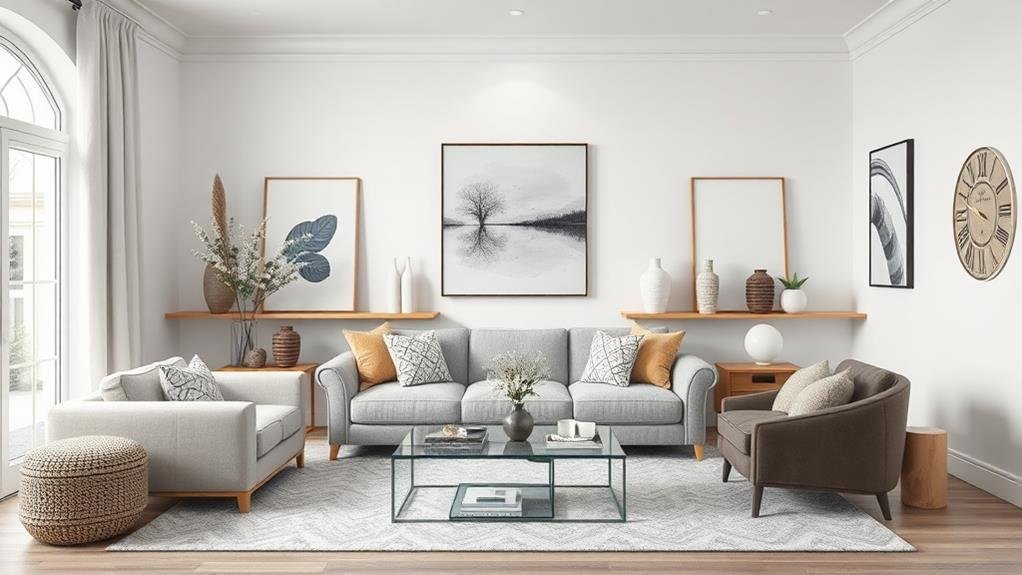
Enhancing your interior space with carefully curated accessories and accents can truly elevate the overall aesthetic and ambiance of a room. To make a statement, incorporate bold contrasts through statement pieces like a vibrant art piece against a neutral wall.
Utilize decorative accents such as throw pillows, rugs, and vases to infuse personality and warmth. Seasonal decor can bring a refreshing change, so consider swapping out cushions or adding festive wreaths.
Create cohesion by selecting items that align with a specific theme like modern, rustic, or bohemian. Experiment with layering techniques by combining textures and colors to add depth and visual interest.
Incorporate personal memorabilia or cultural influences for a personalized touch. Embrace artistic expressions through unique sculptures or handmade crafts.
For a sleek look, focus on minimalist details that emphasize simplicity and elegance. Remember, accessories and accents are the finishing touches that can transform a space into a true reflection of your style and taste.
Storage Solutions
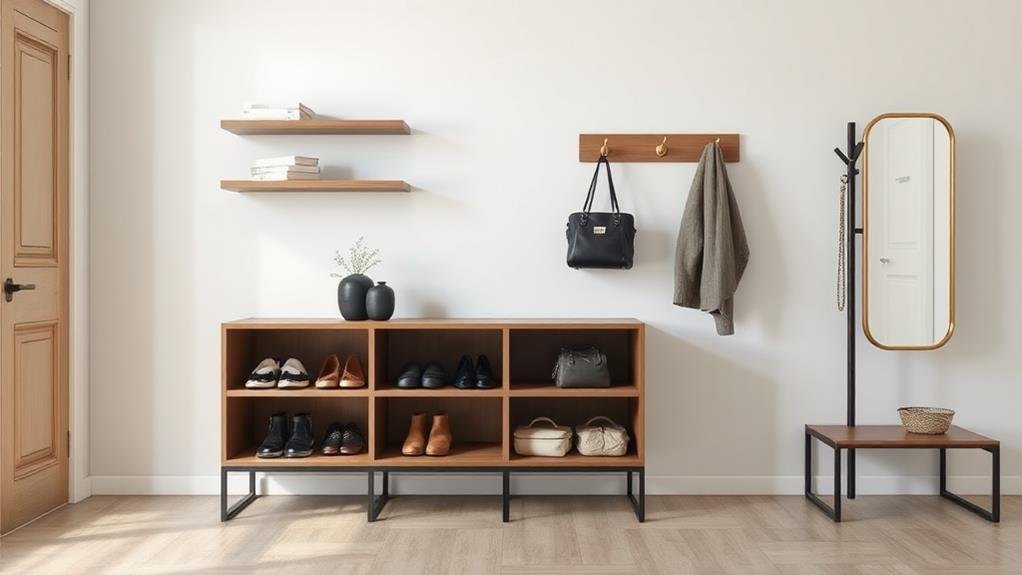
To maximize the functionality and organization of your interior space, implementing smart storage solutions is key.
When it comes to organizing your living area efficiently, considering hidden storage and multi-functional furniture can make a significant difference.
Here are some innovative storage solutions to enhance your space:
- Creative organization: Utilize decorative baskets for a stylish and practical way to keep smaller items organized.
- Modular shelving: Opt for modular shelving units that can adapt to your changing storage needs.
- Under bed solutions: Make the most of underutilized space by incorporating storage solutions under the bed.
- Built-in cabinets: Built-in cabinets provide a seamless storage solution while optimizing space.
- Repurposed items: Get creative by repurposing items like old crates or trunks for unique storage options.
Personal Touches
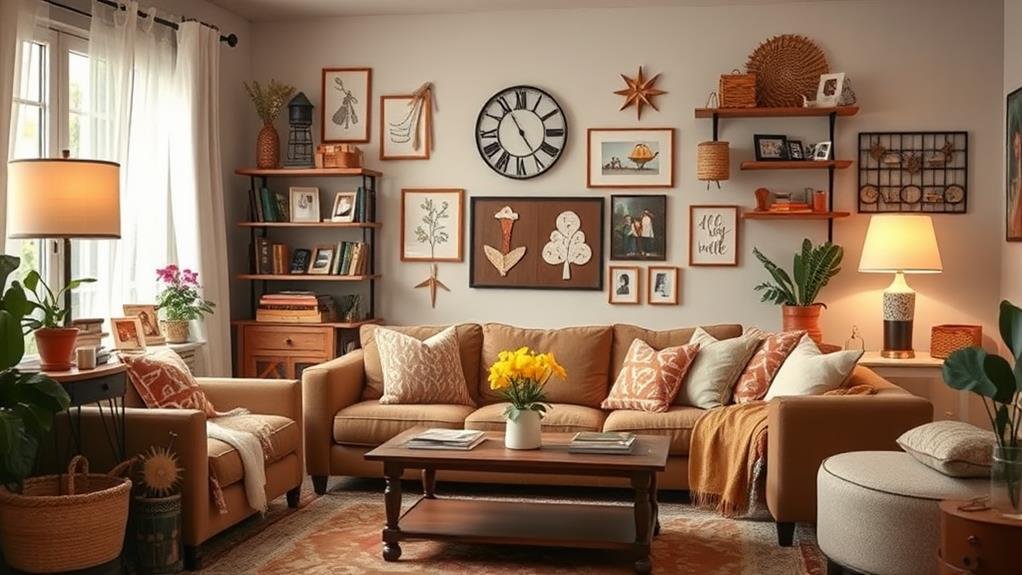
Adding personal touches to your interior space can truly transform it into a reflection of your unique style and personality. Incorporating family heirlooms, personal mementos, or sentimental items can infuse warmth and nostalgia into your home.
Displaying travel souvenirs proudly showcases your adventures and experiences, while incorporating your favorite colors adds a pop of vibrancy that resonates with you. Unique artifacts and hobby displays not only serve as conversation starters but also reflect your passions and interests.
Cultural influences can be subtly woven through artwork or decor pieces, adding layers of depth to your design. Your space becomes a mirror of your lifestyle and values, creating an emotional connection every time you walk through the door.
Functionality vs. Aesthetics
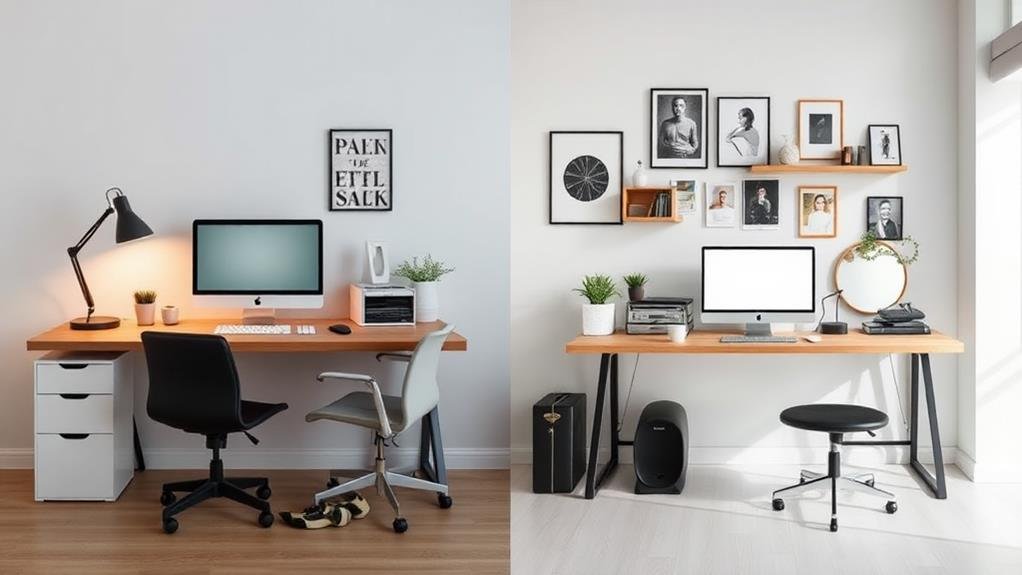
When crafting an interior space, the intersection of functionality and aesthetics is where your design prowess shines.
You must find the delicate balance between meeting the practical needs of the space and creating a visually pleasing environment.
Embracing the idea of form meeting function leads to a harmonious design that not only looks good but also works seamlessly, creating a space that's both beautiful and purposeful.
Balance of Needs
Achieving a harmonious balance between functionality and aesthetics is a fundamental aspect when considering interior design.
As you delve into designing a space, remember to honor both the practical requirements and the visual appeal to create a truly exceptional environment.
Here are some key considerations to keep in mind:
- User Preferences: Tailoring the design to match the tastes and needs of those who'll inhabit the space is crucial for a personalized touch.
- Lifestyle Considerations: Integrate elements that align with your daily routines and activities to enhance the functionality of the space.
- Sensory Experience: Pay attention to how different elements like textures, scents, and colors can influence the overall ambiance.
- Cultural Influences: Infuse elements that reflect your heritage or interests to add depth and character to the design.
- Accessibility Features: Ensure that the design is inclusive and accommodates all individuals, regardless of ability.
Form Meets Function
To create an impressive interior design, you must navigate the intricate relationship between functionality and aesthetics. The fusion of practical aesthetics and user experience is crucial in interior design.
Design psychology plays a key role in creating spaces that aren't only visually appealing but also enhance the overall well-being of the occupants. When considering form meeting function, think about the concept of multifunctional spaces. By employing a minimalistic approach, you can achieve both spatial harmony and workflow efficiency.
Ergonomic design principles should guide furniture and layout choices to ensure comfort and productivity. It's essential to strike a balance between aesthetics and functionality to create spaces that are both visually pleasing and highly practical.
Embracing aesthetic functionality allows for the seamless integration of design elements that serve a purpose beyond mere decoration. Remember, space optimization is key in interior design.
Harmony in Design
Creating harmonious interior design involves skillfully balancing functionality and aesthetics to ensure a space that not only looks visually appealing but also serves its intended purpose effectively.
To achieve this balance, designers must consider various elements to create a cohesive and pleasing environment:
- Design Principles: Adhering to fundamental design principles ensures a solid foundation for your creative endeavors.
- Visual Rhythm: Establishing a rhythm in design elements guides the eye smoothly through the space.
- Spatial Flow: Thoughtful arrangement of furniture and decor enhances the flow and usability of a room.
- Color Harmony: Harmonizing colors evokes specific moods and creates a sense of unity within the space.
- Emotional Impact: Incorporating elements that resonate with emotions enhances the overall ambiance and experience of the space.
Conclusion
As you put the finishing touches on your interior design project, remember that every element plays a vital role in creating a cohesive and inviting space. Just like a perfectly composed symphony, each color, piece of furniture, and lighting placement harmonize together to evoke a sense of beauty and comfort. By paying attention to these essential elements, you are not just designing a room, but creating a masterpiece that reflects your own unique style and personality.

